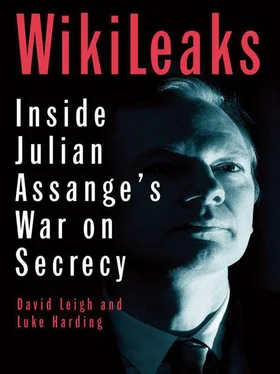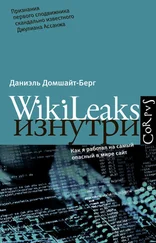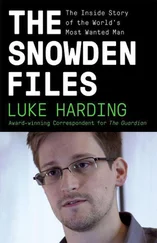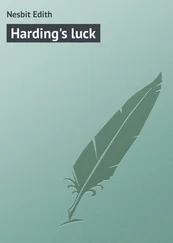Harding, Luke - WikiLeaks - Inside Julian Assange's War on Secrecy
Здесь есть возможность читать онлайн «Harding, Luke - WikiLeaks - Inside Julian Assange's War on Secrecy» весь текст электронной книги совершенно бесплатно (целиком полную версию без сокращений). В некоторых случаях можно слушать аудио, скачать через торрент в формате fb2 и присутствует краткое содержание. Жанр: Старинная литература, на английском языке. Описание произведения, (предисловие) а так же отзывы посетителей доступны на портале библиотеки ЛибКат.
- Название:WikiLeaks: Inside Julian Assange's War on Secrecy
- Автор:
- Жанр:
- Год:неизвестен
- ISBN:нет данных
- Рейтинг книги:3 / 5. Голосов: 1
-
Избранное:Добавить в избранное
- Отзывы:
-
Ваша оценка:
- 60
- 1
- 2
- 3
- 4
- 5
WikiLeaks: Inside Julian Assange's War on Secrecy: краткое содержание, описание и аннотация
Предлагаем к чтению аннотацию, описание, краткое содержание или предисловие (зависит от того, что написал сам автор книги «WikiLeaks: Inside Julian Assange's War on Secrecy»). Если вы не нашли необходимую информацию о книге — напишите в комментариях, мы постараемся отыскать её.
WikiLeaks: Inside Julian Assange's War on Secrecy — читать онлайн бесплатно полную книгу (весь текст) целиком
Ниже представлен текст книги, разбитый по страницам. Система сохранения места последней прочитанной страницы, позволяет с удобством читать онлайн бесплатно книгу «WikiLeaks: Inside Julian Assange's War on Secrecy», без необходимости каждый раз заново искать на чём Вы остановились. Поставьте закладку, и сможете в любой момент перейти на страницу, на которой закончили чтение.
Интервал:
Закладка:
The field reports almost never contained any direct admissions of misbehaviour: these entries are written by comrades, and designed to be viewed by more senior officers. But the Americans were a little less inhibited when giving accounts of the conduct of their allies than they were when writing up their own behaviour. As a result, David Leigh and his colleague Rob Evans were able to tease out clusters of what looked like excessive use of force against civilians on the part of certain British units. They identified a detachment of the Coldstream Guards which had recently taken up position at Camp Soutar in Kabul. The Coldstream Guards’ unofficial blog described their mood at the time: “The overriding threat is that of suicide bombers, of which there have been a number in the recent past.”
Four times in as many weeks, this unit appears to have shot civilians in the town in order to protect its own members. The worst was on 21 October 2007, when the US soldiers reported a case of “blue-on-white” friendly fire in downtown Kabul, noting that some unknown troops had shot up a civilian vehicle containing three private security company interpreters and a driver. The troops had been in “a military-type vehicle that was brown with a gunner on top … There were no US forces located in the vicinity of the event that may have been involved. More to follow!” They updated a short while later, saying “INVESTIGATION IS CONTROLLED BY THE BRITISH. WE NOT ABLE TO GET THE COMPLETE STORY. THIS EVENT BELONGS TO THE BRITISH ISAF FORCES.”
It took another three months’ stalling, after the WikiLeaks logs went public, before the Ministry of Defence in London admitted these Kabul shootings had indeed taken place. They confirmed the British patrol had shot dead one civilian and wounded two others in a silver minibus. It was claimed the minibus failed to stop when the soldiers signalled for it to do so.
A few days after the minibus shooting, on 6 November, the British reported around midday that they had wounded another civilian in Kabul in broad daylight with what was at first claimed to be a “warning shot”. At the end of the afternoon, the Americans heard the man had died, and there might be trouble: “There could be some demonstration, the civilian was a son of an Afghan aviation general, his wedding was planned for this evening with numerous people.” They later updated: “It was not the wedding of the dead person. The wedding for this evening was planned for his brother but now it is cancelled. The family will get the dead body tomorrow morning.” Again the British army eventually confirmed this WikiLeaks disclosure after a long delay: the official British version is that the general’s son had “accelerated” his Toyota towards a patrol, leaving the soldiers only time for a shouted warning before firing at the car. The car then skidded to a halt and a man fell out, they say.
These events, and hundreds like them, together constitute the hidden history of the war in Afghanistan, in which innocent people were repeatedly killed by foreign soldiers. The remarkable level of detail provided by the war logs made it accessible for the first time.
*
However, while the European media focused on the sufferings of civilians, the New York Times tended to take a more strategic approach to the Afghan war. One of their major interests was to study the large – and often surprising – quantity of evidence in the war logs that US efforts to suppress the Taliban were being hampered by Pakistan. There were repeated detailed entries telling of clashes or intelligence reports in which Pakistan’s intelligence service, the ISI, appeared to be the villain, covertly backing the Taliban for reasons of its own.
The Obama administration had a relatively sophisticated response to this information, which it was aware the papers had discovered. It used the situation to project a message. As the logs were published at 10pm GMT on Sunday evening, a White House spokesman emailed newspapers’ Washington correspondents a note not intended for publication under the subject line: “Thoughts on WikiLeaks”. They even attached some handy quotes from senior officials highlighting concerns about the ISI and safe havens in Afghanistan. “This is now out in the open,” a senior administration official told the New York Times . “It’s reality now. In some ways, it makes it easier for us to tell the Pakistanis that they have to help us.” A spokesman stated in public: “The safe havens for violent extremist groups within Pakistan continue to pose an intolerable threat to the United States, to Afghanistan, and to the Pakistani people.”
The British prime minister, David Cameron, on a two-day trip to India, chimed in, in what seemed a synchronised way. Speaking to a business audience in Bangalore two days after the war logs were released, he signalled the same hard line. “We cannot tolerate in any sense the idea that this country [Pakistan] is allowed to look both ways and is able to promote the export of terror, whether to India or Afghanistan or anywhere else in the world,” he said. “That is why this relationship is important. But it should be a relationship based on a very clear message: that it is not right to have any relationship with groups that are promoting terror. Democratic states that want to be part of the developed world cannot do that. The message to Pakistan from the US and from the UK is very clear on that point.”
It was a surprising turn of events, confirming what most investigative journalists know instinctively, that full disclosure of hitherto secret information can stimulate all kinds of unexpected outcomes. The Guardian summed up in an editorial the purpose of its co-operation with WikiLeaks:
The fog of war is unusually dense in Afghanistan. When it lifts, as it does today … a very different landscape is revealed from the one with which we have become familiar. These war logs – written in the heat of engagement – show a conflict that is brutally messy, confused and immediate. It is in some contrast with the tidied-up and sanitised “public” war, as glimpsed through official communiqués as well as the necessarily limited snapshots of embedded reporting … The Guardian has spent weeks sifting through this ocean of data, which has gradually yielded the hidden texture and human horror stories inflicted day to day during an often clumsily prosecuted war. It is important to treat the material for what it is: a contemporaneous catalogue of conflict. Some of the more lurid intelligence reports are of doubtful provenance: some aspects of the coalition’s recording of civilian deaths appear unreliable. The war logs – classified as secret – are encyclopedic but incomplete. We have removed any material which threatens the safety of troops, local informants and collaborators.
With these caveats, the collective picture that emerges is a very disturbing one. We today learn of nearly 150 incidents in which coalition forces, including British troops, have killed or injured civilians, most of which have never been reported; of hundreds of border clashes between Afghan and Pakistani troops, two armies which are supposed to be allies; of the existence of a special forces unit whose tasks include killing Taliban and al-Qaida leaders; of the slaughter of civilians caught by the Taliban’s improvised explosive devices; and of a catalogue of incidents where coalition troops have fired on and killed each other or fellow Afghans under arms …
In these documents, Iran’s and Pakistan’s intelligence agencies run riot. Pakistan’s Inter-Services Intelligence is linked to some of the war’s most notorious commanders. The ISI is alleged to have sent 1,000 motorbikes to the warlord Jalaluddin Haqqani for suicide attacks in Khost and Logar provinces, and to have been implicated in a sensational range of plots, from attempting to assassinate President Hamid Karzai to poisoning the beer supply of western troops. These reports are unverifiable and could be part of a barrage of false information provided by Afghan intelligence. But yesterday’s White House response to the claims that elements of the Pakistan army had been so specifically linked to the militants made it plain that the status quo is unacceptable. It said that safe havens for militants within Pakistan continued to pose “an intolerable threat” to US forces. However you cut it, this is not an Afghanistan that either the US or Britain is about to hand over gift-wrapped with pink ribbons to a sovereign national government in Kabul. Quite the contrary. After nine years of warfare, the chaos threatens to overwhelm. A war fought ostensibly for the hearts and minds of Afghans cannot be won like this.
Читать дальшеИнтервал:
Закладка:
Похожие книги на «WikiLeaks: Inside Julian Assange's War on Secrecy»
Представляем Вашему вниманию похожие книги на «WikiLeaks: Inside Julian Assange's War on Secrecy» списком для выбора. Мы отобрали схожую по названию и смыслу литературу в надежде предоставить читателям больше вариантов отыскать новые, интересные, ещё непрочитанные произведения.
Обсуждение, отзывы о книге «WikiLeaks: Inside Julian Assange's War on Secrecy» и просто собственные мнения читателей. Оставьте ваши комментарии, напишите, что Вы думаете о произведении, его смысле или главных героях. Укажите что конкретно понравилось, а что нет, и почему Вы так считаете.












